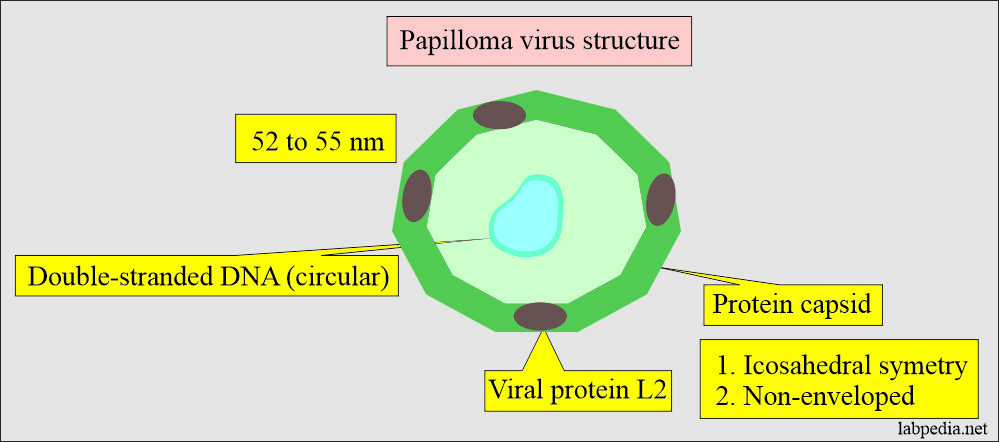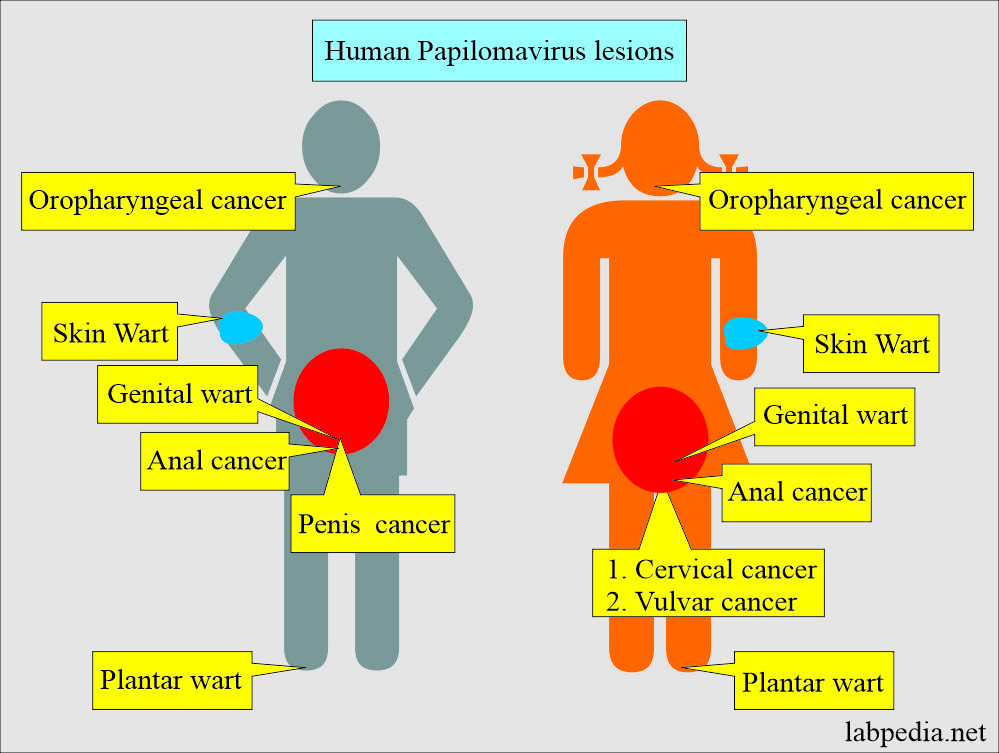Human Papillomavirus (HPV), Diagnosis and Treatment
Human Papillomavirus (HPV)
What sample is needed for Human Papillomavirus (HPV)?
- The sample can be taken with an Endocervical swab.
- Take a biopsy sample from the affected tissue.
What are the indications for Human Papillomavirus (HPV)?
- Isolation of the Human papillomavirus.
How will you define Human Papillomavirus (HPV)?
- This virus is double-stranded DNA without an envelope.
- Papova means papillomavirus, polyomavirus, causing perinuclear vacuolization.
- >50 strains of Human papillomavirus are described.
- The most common clinical manifestations are warts (skin) and condyloma (in the genital area).
- This double-stranded DNA virus infects the squamous epithelium and gives a spectrum of diseases of the skin, respiratory system, and genital tract, from warts to dysplasia to carcinoma.
How will you define the pathophysiology of the Human Papillomavirus (HPV)?
- Human papillomavirus (HPV) belongs to the Papovaviridae family.
- This is also called the wart virus.
- It measures 44 to 55 nm.
- This is a double-stranded DNA virus.
- This is icosahedral, and no envelope.
- This virus can cause the infection of:
- Hands, feet, arms, and forehead.
- Larynx.
- Genitalia.
- In the case of cervical lesions, HPV types 6 and 11 are associated with low-grade malignancy.
- HPV types 31, 33, and 35 are seen in low-grade malignancies.
- HPV types 16 and 18 are found in high-grade malignancies.
- Various types of warts/lesions are:
- Verruca plantaris are caused by HPV-1.
- Verruca Vulgaris is caused by HPV-2.
- Condyloma acuminatum is caused by HPV-6, 11.
- laryngeal papilloma is caused by HPV-6, 11.
- Cervical and laryngeal dysplasia/carcinoma is caused by HPV-16, 18, 31, 33.
- Papillomaviruses are tropical for the epithelial cells of the skin and mucous membranes.
- Viral nucleic acid can be found in basal stem cells.
- This virus causes cervical and squamous cell carcinoma of the head and neck.
- Biological and molecular studies show that the disease progresses slowly.
- HPV-16 and 18 are considered to be high-risk viruses for cancers.
- HPV-31 is classified as an intermediate-risk virus.
- HPV-6, 11 are considered low-risk viruses for cancers.
How will you classify Human papillomavirus (HPV) and its relation to various diseases?
| Type of papilomavirus | Disease |
|
|
|
|
|
|
|
|
|
|
|
|
|
|
|
|
|
|
What is the incubation period of Human Papillomavirus (HPV)?
- Warts take 1 to 8 months once the virus settles in the area.
- Genital warts develop after 1 to 3 months.
- The wart is more common in children and young adults. These are uncommon in older adults.
What is the structure of the Human Papillomavirus (HPV)?
- Papillomaviruses are non-enveloped viruses without a lipid layer, with a capsid consisting of protein.
- It contains a large genome of 8 kb. This genome is very complex.
- There is double-stranded DNA in a circular shape.
- The papillomavirus is slightly larger in size, measuring roughly 52 to 55 nm.
Give a summary of the features of Human Papillomavirus (HPV)?
| Parameters | Characteristic features |
|
|
|
|
|
|
|
|
|
|
|
|
|
|
|
|
|
|
|
|
How will Human Papillomavirus (HPV) spread?
- Human Papillomavirus (HPV) spreads :
- In genitalia through sexual contact (unprotected anal, vaginal, or oral sex).
- Transmission of cutaneous HPV is by direct contact, skin to skin (handshakes or hugs).
- This may spread during pregnancy (mother to baby, labor, and nursing).
- Some people have no symptoms but can spread the disease through sexual contact.
What are the signs and symptoms of Human Papillomavirus (HPV)?
- It is dependents on the area involved:
- Warts are tender when these are irritated.
- Warts are seen on hands, feet, arms, forehead, larynx, and genitalia.
- Anal warts cause itching called venereal wart Condylomata.
- Different kinds of warts are:
- Skin wart. Non-plantar warts are usually associated with HPV-2.
- Plantar warts. HPV-1 is associated with warts on the sole of the foot.
- Flat warts.
- Genital condyloma.
- Laryngeal papilloma.
- Palmer warts are sensitive to pressure.
- HPV-associated sexually transmitted genital lesions are becoming more common.
- Cervical cancers in women are common worldwide and a major cause of death in developing countries.
- HPV-6 and 11 are associated with low-grade cervical dysplasia (CIN I and II).
- HPV-16 and 18 are seen in 80% to 95% of high-grade cervical dysplasia (CIN III) and some cases of carcinoma of the penis.
- HPV-16 is also associated with squamous cell carcinoma in situ of the anogenital area skin (Bowen’s disease) and invasive carcinoma of the anal area.
- The majority of cervical, penile, and valvular cancers carry HPV-DNA.
- These lesions show HPV-16 and HPV-18, and these types are more common.
What is the classification of the Human papillomavirus and its relation to diseases?
| Type of Human papillomavirus | Clinical presentations | The outcome of the infection |
|
|
|
|
|
|
|
|
|
|
|
|
|
|
|
|
|
|
|
|
|
|
|
|
|
|
|
|
|
|
|
|
|
|
|
|
|
|
|
|
|
|
How will you describe the epidemiology of Human Papillomavirus (HPV)?
- This may become chronic and may last many years or lifelong.
- In the USA, this disease is very common; roughly 3 million cases are reported.
- Another reference says 80 million cases in the USA, according to the CDC.
- 14 million people, including teenagers, will suffer from this infection each year.
How will you diagnose Human Papillomavirus (HPV)?
- Diagnosis is made with immunohistologic stains or nucleic acid DNA probes on cervical biopsy.
- A cervical biopsy gives more positive results than a cervical scraping smear.
- It can find the virus in Papanicolaou stain cells of the cervical smear.
- Or can advise liquid-based cytology.
- PCR for detection of HPV.
- HPV DNA hybridization technology.
How will you treat Human Papillomavirus (HPV)?
- Warts need surgical excision.
- Also, can try electro-dissection.
- Can use acid.
- It can freeze with liquid nitrogen.
- Sometimes, it may disappear without any treatment.
What are the complications of human papillomavirus?
- The most common complication is cervical cancer in females. It is found in 90% of cases.
- This is also found in cancers of the vulva, penis, anal canal, and head and neck.
How will you prevent Human Papillomavirus (HPV)?
- Avoid contact with HPV-positive patients.
- Condom use can prevent infection.
- The vaccine can be recommended to prevent HPV (for genital warts and cervical cancers).
- HPV vaccine Cervarix prevents types 16 and 18.
- These types are 70% of the cause of cervical cancers.
- All boys and girls must be vaccinated at 11 or 12 years old.
Questions and answers:
Question 1: What is the nature of Human papillomavirus.?
Question 2: What is the main complication of human papillomavirus?



The viral structure used is HIV not HPV.
Please see now the structure.
https://labpedia.net/human-papillomavirus-hpv/
Thanks for pointing the mistake, and it is corrected.